What’s Buggin’ You?
(Not all bugs are pesky, some are beneficial to your garden. Read on for a glimpse of both.)
Most of us here in San Antonio are starting to really enjoy the fruits of our labor. Our perennials that we’ve mulched, and fed are rearing up from the ground ready to put on a colorful display. Our tomatoes have set fruit and are reaching out to the tops of our tomato cages. Our roses are putting on a spectacular display from recent rains. All is good, right? Maybe, but maybe not. If you’ve overlooked one step in caring for your plants, you might not be enjoying them as much as something else is. Pests! If you haven’t developed a good schedule (preventative and/or maintenance) to combat the tiny world that loves nothing more than to feast on your vibrant, healthy flowers or your juiciest vegetables, it’s not too late. You can still save your plants!
(Off to Rainbow Gardens with bagged up specimens)
Identification of the pest is key to getting the correct product, whether organic or synthetic, to effectively do the job. We have a couple examples here to get you started, but we can really help you out if you confiscate the little rascals, seal them up in a clear plastic baggie and bring them in for us to clearly identify them. Another way we can usually identify pests is by a sample of the leaves they are demolishing. Again, slide them in a plastic baggie to keep them confined and bring them on in. Below are a few pests that you are likely to encounter, and a few beneficial insects as well.
(Oh no…looks like Thrips got to this rose!)
Thrips are the bane of rose growers and that’s not the only flower these tiny pests like to inhabit. Many a hibiscus have fallen prey to them, as well as any flower that forms a nice tight bud before blooming. You probably don’t even notice them until you see that your rose buds all have crinkled, dried up edges on the petals. Then you begin to take more notice that the roses look dead before you even get to enjoy them. Sometimes the buds don’t even open up and fall right off the bush. You douse the plant with insecticide trying to rid yourself of whatever is attacking it.
(Aha! Look closely and you can see the tiny yellow thrips)
Take a second and look closer, even closer yet. Peel back the petals of the buds and look inside. See any teeny, tiny yellow bugs scrambling to get closer to the center of the flower? There are your culprits. thrips love to nestle in the layers of your newly forming blooms and suck the life out of the flowers. That is where you need to focus the spraying of your insecticide. Zero in on the flowers, not the leaves of the plant. Remove spent flowers on a regular basis to prevent a “safe house” for the thrips to infest. One of the best synthetic products for thrips is Systemic Insecticide. If you choose to go the organic route, you can use a product like Spinosad. Follow the instructions on the bottle and be sure to follow up with treatment as stated.
(Aphid infestation at it’s best/worst?)
Aphids are a very common pests. These little creatures come in a variety of colors, although light green is most common, and they love to suck the sap and life out of your plants. They cause the plant to weaken and become deformed with curled up leaves and often a sticky, sooty mold substance all over the plant. They puncture the leaves of plants making a gateway for disease to easily enter. If you start to see misshapen, yellow leaves on your plants, take a look underneath the leaf and see if you find a few aphids clinging happily in their favorite hiding place.
(Ladybug taking care of business…you go girl!)
Sometimes you can blast the aphids with a garden hose and dislodge them that way. But you might need to get some insecticidal soap, or products like Pyrethrin and Spinosad to rid yourself of them. You can also purchase beneficial insects such as ladybugs, which feed on aphids. Try to take care of aphids when you first notice them, because they reproduce quickly and can turn into an infestation quickly.
(No, this is not a road map, it’s leafminer damage )
You may be inspecting your plants and think you see a dried up worm on your leaves. With a closer look, you realize there is no worm on your plant but something has definitely carved a twisting, winding path through your fresh green leaf. You have found the telltale signature of the leafminer. Leafminers are the larvae of moths, beetles, and flies. These insects lay their larvae on leaves, and the larvae makes it’s way eating a twisty trail through the leaf. The damage from leafminers is mostly aesthetic. You can remove the affected leaves, which in turn, removes the larvae before it turns into an adult and produces it’s own larvae, thus breaking the cycle. If you have a plant you know is susceptible to leafminers, you can treat it with Neem oil in early spring before the insects have a chance to lay their eggs. Leafminers can also be controlled by the product Spinosad. The leafminer must ingest the Spinosad, so you may need to repeat applications.
(Slippery, slimy, slithering slugs and snails)
Just the word slug can make the hairs on the back of your neck stand up. They can totally demolish your prized hostas, and beautiful Delphinium, and they don’t stop there. You’ll probably first notice a large hole in a plant leaf. If you look around the base of the plant, you might find a trail of slime on the leaves and rocks around the base of the plant. Little pearly white eggs might be laid there as well. This is the time to be on the lookout for slugs because they lay their eggs in the early weeks of summer and only take 3-4 weeks to hatch, and then they are on the lookout to feed on your plants. Remove as much debris as you can away from your plants, that’s where slugs like to hide.
(Looks kind of cute here, but it’s a face only a mother could love!)
You can use natural methods to try and deter slugs, such as placing sharp, crushed up objects around the base of the plant you are trying to protect, the same effect (without cuts to your fingers) can be applied by sprinkling Diatomaceous Earth (the non-toxic, food grade variety) around the base of the plant. Diatomaceous Earth works in dry conditions, the slugs crawl across it with their soft bodies and it basically cuts them and cause them to dehydrate. Nice, right? You can opt for commercial products like Sluggo, and Slug Death as well. As always, when using synthetic pesticides check for toxicity to your domestic animals.
(Yes, he likes to chew, but he needs his energy to grow wings!)
Sure they can chomp away at your leaves and leave you with a wispy chewed up stem, but remember what they turn into? Everyone seems to have a different opinion about these guys. If they are chomping away at a veggie garden, you might pluck them off and displace them, or if you must, treat them with a product like BT, never use systemic insecticide on your edible plants. A lot of people choose to plant species specifically for caterpillars to munch on. Fennel, rue, dill, and milkweed are just a few plants you could choose to offer these hungry munchers. If you plant pentas, butterfly bush, lantana, jatropha and other butterfly attracting plants, you could possibly see the full life cycle of your very hungry caterpillar.
(What a helpful little lady.)
Well, it’s time to end on a positive note. With all the pesky creatures that can invade your lawn, flower beds, and vegetable gardens, it’s nice to know that there are some creatures out there that are trying to help you in your fight to keep your plants alive. These are categorized as beneficial insects, and they are basically trying to do the job that all your pesticides and insecticides promise to do. They get their meals from gobbling up the damaging insects that prey on your leafy greens. Ladybugs love to make a meal out of aphids, spider mites, white flies, and scale insects. However, don’t make the mistake of spraying pesticides in conjunction with releasing your beneficial insects, or you risk killing them along with the unwanted pests.
(Looks like he is very alert and ready to attack your pests.)
Praying Mantis also dine on spider mites, as well as moths (stopping them from laying eggs on your leaves), and caterpillars. Beneficial Nematodes are great microscopic predators that swim down to the depths of the roots of plants and chomp grubs, fleas, termites, webworms, and much more. Come into Rainbow Gardens and learn all about beneficial insects and how to use them in controlling your peskiest pests.
Whichever method you choose, remember prevention, maintenance, and consistency is the key.
The Happy Gardener

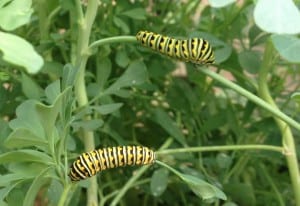
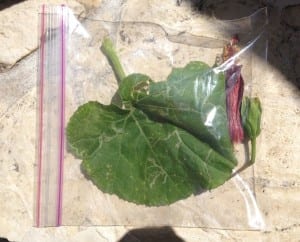



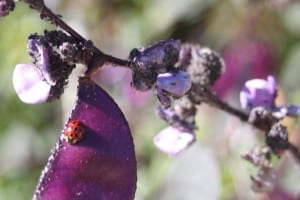


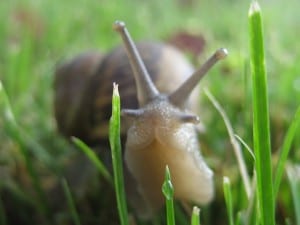

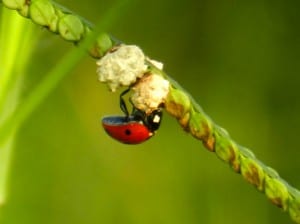

Thank you👏🏻👏🏻